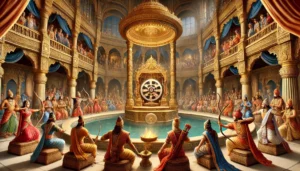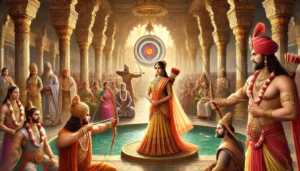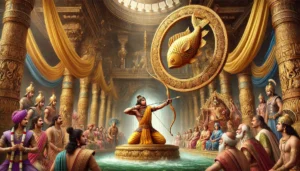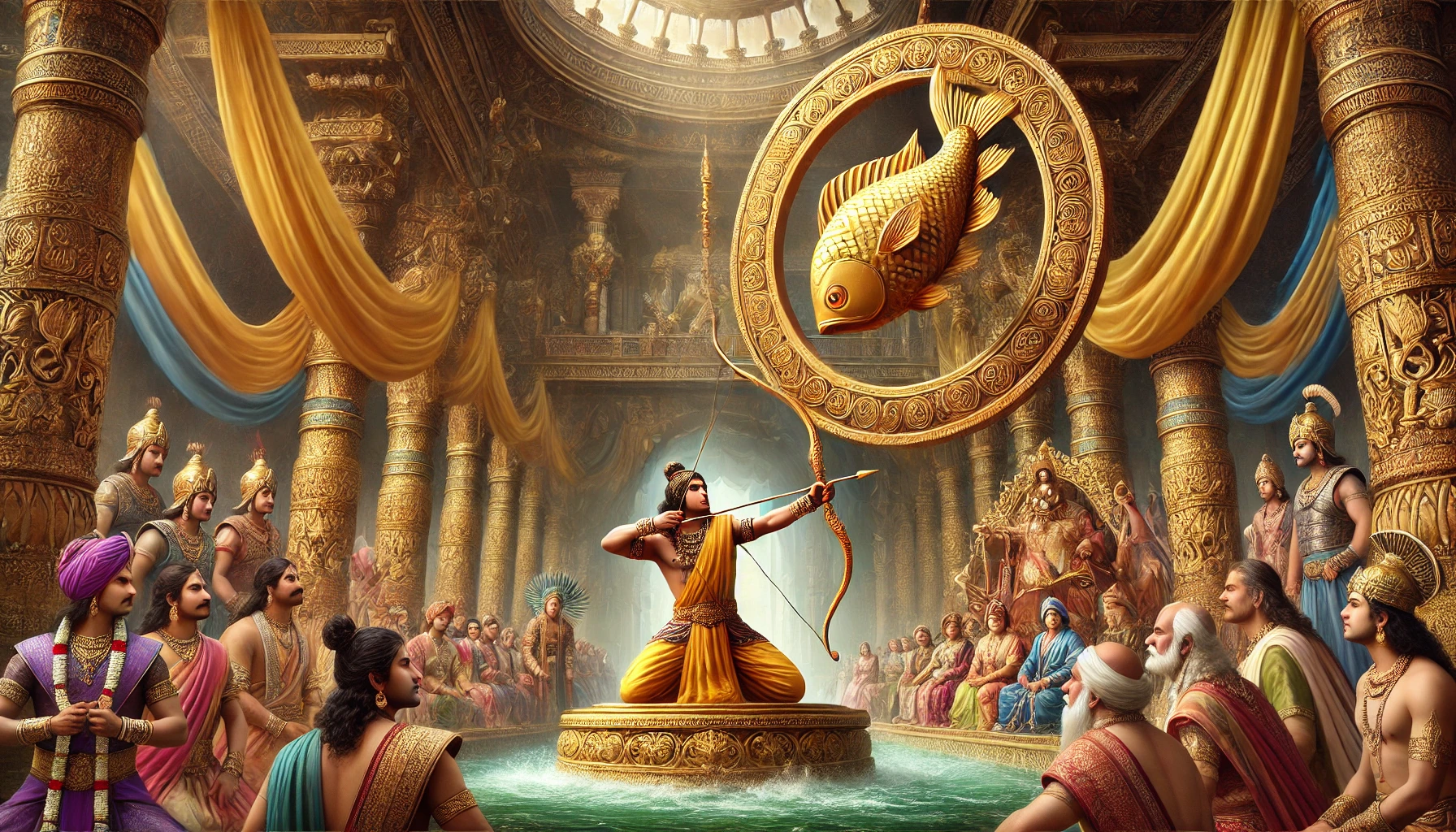
Draupadi Swayamvar archery test explained
Draupadi Swayamvar: The Test of Skill and Precision
The Draupadi Swayamvar is a pivotal event in the Mahabharata, marking the intersection of destiny, skill, and honor. This grand event was not just a marriage ceremony but a test of the greatest warriors of the time. It was a moment where valor, precision, and righteousness were put to the ultimate challenge. The outcome of this contest determined the fate of Bharatvarsha and set in motion a chain of events that ultimately led to the Kurukshetra war.
The Origins: Why Draupadi’s Swayamvar Was Special?
Unlike other swayamvars, where a princess could choose her groom freely, Draupadi’s father, King Drupada, had laid out an extreme test of skill. This was not only because he wanted a great warrior for his daughter, but also because of his own desire for revenge. Drupada had been humiliated by Drona, his childhood friend turned rival, and he believed that only Arjuna, Drona’s finest disciple, could help him restore his honor.
To ensure that only the most deserving warrior won Draupadi’s hand, Drupada arranged a test so difficult that only the most skilled archer in the world could accomplish it.
The Challenge: A Test of Strength and Precision
The contest was simple in theory but nearly impossible in execution:
- A gigantic bow was placed in the court, one that required immense strength to even lift.
- A mechanical fish was suspended high above, constantly revolving.
- The challenge was to pierce the eye of the fish using an arrow.
- The catch? The archer could not look at the fish directly. Instead, he had to aim by watching its reflection in a bowl of water placed below.
This required not just brute strength, but unparalleled focus, patience, and mastery over archery—qualities that only a few warriors in history possessed.
Table of Contents

Draupadi Swayamvar archery test explained
The Grand Assembly of Kings and Warriors
The Swayamvar was one of the largest gatherings of warriors in history. Kings, princes, and heroes from all corners of Bharatvarsha attended, hoping to win the hand of the stunning Draupadi, who was considered the embodiment of beauty, wisdom, and dharma. Among the attendees were:
- Duryodhana – The prince of Hastinapura, a mighty warrior but primarily a mace fighter rather than an archer.
- Karna – The King of Anga, an unparalleled archer who could match Arjuna in skill.
- Shishupala – The powerful ruler of Chedi, known for his arrogance.
- Jarasandha – The mighty King of Magadha, an enemy of Krishna and the Pandavas.
- Shalya, Bhagadatta, and other renowned warriors.
Unknown to all, the Pandavas, who were living in exile disguised as Brahmins, also arrived at the Swayamvar. They had heard of the event and attended as spectators, not knowing that fate would soon place them at the center of it.
The Failed Attempts of the Greatest Warriors
The contest began, and one by one, the mighty warriors tried and failed. Many struggled to even lift the bow. Duryodhana and Shishupala failed miserably. Some could lift it but could not string it.
Then came Karna, who effortlessly picked up the bow, astonishing everyone with his strength. As he prepared to take the shot, Draupadi intervened. She declared, “I will not marry a suta putra”, implying that a charioteer’s son was unworthy of her hand.
This moment remains one of the most controversial in the Mahabharata. Some say Draupadi was guided by destiny, as Karna’s victory would have changed history. Others believe her words were influenced by Krishna, who wished to prevent Karna from winning.
Karna, deeply insulted, dropped the bow and withdrew, his heart burning with humiliation. This moment would sow the seeds of his deep hatred for the Pandavas and Draupadi.
The Brahmin Who Stood Up: Arjuna’s Victory
When all the kings failed, a humble Brahmin youth stood up. The entire court was stunned. Who was this Brahmin daring to attempt what the greatest warriors could not?
The youth was Arjuna in disguise. Despite his humble appearance, he walked with the confidence of a warrior.
As everyone watched in disbelief:
- Arjuna effortlessly lifted the bow, proving his unmatched strength.
- He strung it with ease, something even Karna hadn’t been allowed to do.
- He fixed his gaze on the water, focusing on the reflection of the moving fish.
- With calm precision, he took aim and released his arrow.
The arrow shot through the air and pierced the eye of the fish perfectly! The court erupted in shock and admiration—a mere Brahmin had succeeded where the mightiest kings had failed!
The Outrage and Battle in the Court
As Draupadi approached Arjuna with the victory garland, the assembled kings were furious. They refused to accept a Brahmin as the winner and launched an attack.
- Karna and Shalya charged forward, ready to challenge him.
- Duryodhana and his allies prepared to fight.
- But before they could strike, Bhima, disguised as another Brahmin, intervened.
- Bhima single-handedly defeated the attacking kings, displaying his incredible strength.
Seeing the unmatched skills of these “Brahmins,” the warriors began to suspect the truth—these were not ordinary men.
The Aftermath: The Pandavas’ True Identity Revealed
Arjuna and Draupadi returned to their humble home, where Kunti, unaware of what had transpired, told them to share whatever they had brought. This led to the unique polyandrous marriage of Draupadi with all five Pandavas, fulfilling an ancient prophecy.
Soon after, their true identities were revealed. The Kauravas were shocked and enraged to learn that the Pandavas were alive. Hastinapura was now divided, and this event set the course for the power struggle that would ultimately lead to the great war of Kurukshetra.

Draupadi Swayamvar archery test explained
The Significance of Draupadi Swayamvar in the Mahabharata
- A Test of True Skill Over Status
Arjuna’s victory proved that merit and skill triumph over royal lineage. Despite being in exile, he emerged as the greatest archer, reinforcing the idea that dharma (righteousness) and karma (one’s actions) define a person, not birth.
- Draupadi’s Independence and Destiny
Draupadi’s rejection of Karna and her acceptance of Arjuna were not just personal choices but acts of destiny. She would go on to become the driving force behind many key events in the Mahabharata.
- The Seeds of Future Conflicts
Karna’s humiliation at the Swayamvar deepened his hatred for Draupadi and the Pandavas.
The Kauravas’ jealousy intensified, leading to further conspiracies.
Drupada’s wish for an alliance with Arjuna was fulfilled, strengthening the Pandavas’ position.
- A Catalyst for the Kurukshetra War
Draupadi’s Swayamvar was not just a test of archery, but the first spark that ignited the great war. It determined the alliances and enmities that shaped the epic’s climax.
Conclusion
The Draupadi Swayamvar remains a legendary tale of courage, destiny, and righteousness. It was a contest where only the most deserving could win, and Arjuna’s triumph reinforced the eternal truth that real strength lies not in titles, but in one’s skills and devotion to dharma.
Would history have changed if Karna had been allowed to participate? Perhaps. But destiny had already chosen its path, leading to the rise of the Pandavas and the fall of the Kauravas in the great war of Mahabharata.
(FAQs) on “Draupadi Swayamvar: The Ultimate Test of Valor and Precision”:
- What was the significance of Draupadi’s Swayamvar?
Draupadi’s Swayamvar was a grand event organized by King Drupada to find a worthy husband for his daughter. It was not just a marriage ceremony but a test of supreme skill, valor, and divine destiny, as only the most capable warrior could win her hand.
- What was the challenge set for the suitors?
The challenge required the suitors to string a heavy bow and shoot an arrow through the eye of a revolving fish, while only looking at its reflection in the water below. This test demanded extraordinary strength, concentration, and precision.
- Why did King Drupada set such a difficult challenge?
King Drupada wished for a warrior husband for Draupadi, especially someone who could match or surpass Arjuna’s abilities. The challenge ensured that only the most skilled and deserving contender would win her hand.
- Who participated in Draupadi’s Swayamvar?
Many powerful kings and princes, including Duryodhana, Karna, Shishupala, and other prominent Kshatriyas, attended the Swayamvar. However, none of them could successfully complete the challenge—except Arjuna.
- Why was Karna not allowed to participate?
Although Karna was a mighty warrior, Draupadi, influenced by social customs and perhaps divine fate, refused to marry him, stating that she would not wed a Suta (charioteer’s son). This remains a subject of debate and discussion in Mahabharata interpretations.
- How did Arjuna win Draupadi’s hand?
Arjuna, disguised as a Brahmin, stepped forward after all the kings failed. With his unmatched archery skills, he strung the bow effortlessly and shot the target with perfect precision, thus winning Draupadi’s hand.
- What was the reaction of the other suitors?
The assembled kings, including Duryodhana and Shalya, were enraged and refused to accept the victory of a seemingly unknown Brahmin. A battle broke out, but Bhima and Arjuna successfully defended themselves and took Draupadi home.
- How did Draupadi end up marrying all five Pandavas?
When Arjuna brought Draupadi home, he jokingly told his mother, Kunti, that he had won a “prize” in alms. Without seeing Draupadi, Kunti instructed him to share it with his brothers. To uphold her words and under divine circumstances, Draupadi became the wife of all five Pandavas.
- What does Draupadi’s Swayamvar symbolize?
It represents divine intervention, destiny, and the superiority of skill over mere status or power. It also highlights the concept of Dharma, where the most deserving, not necessarily the most powerful, wins.
- How is Draupadi’s Swayamvar relevant today?
The story teaches us that true merit, skill, and destiny outweigh mere status or lineage. It also reflects the importance of resilience, as Draupadi’s life was filled with challenges despite being a queen.
Summary
Draupadi’s Swayamvar was a momentous event in the Mahabharata, symbolizing the ideals of valor, destiny, and divine will. Hosted by King Drupada of Panchala, the event attracted the greatest warriors and kings of the time, all eager to win Draupadi’s hand in marriage. However, it was not a mere matter of choice but a rigorous test of skill and precision. The challenge required the suitors to string a massive celestial bow and shoot an arrow through the eye of a rotating fish, using only its reflection in the water below as a guide.
Many renowned warriors, including Karna and Duryodhana, attempted but failed. Draupadi, bound by her devotion to dharma and personal desire, subtly rejected Karna, believing that only a true kshatriya of noble lineage should win her hand. Finally, an unknown Brahmin youth—Arjuna, disguised as a humble sage—stepped forward. With unmatched focus and mastery over archery, he accomplished the feat effortlessly, leaving the assembly in awe.
Draupadi joyfully garlanded him, but the event soon turned into a conflict as the Kauravas and other suitors questioned the legitimacy of a Brahmin marrying a princess. However, Arjuna and Bhima, under the guidance of Krishna, managed to leave the scene safely. Upon returning home, a fateful twist occurred when Kunti, unaware of the situation, instructed her sons to share whatever they had brought. This led to Draupadi becoming the common wife of all five Pandavas, a unique and unprecedented marital arrangement in Hindu mythology.
Draupadi’s Swayamvar was not just a marriage contest but a pivotal moment that shaped the destiny of the Mahabharata. It established Arjuna’s supreme prowess, reinforced Krishna’s divine role, and sowed the seeds for future conflicts that would culminate in the great Kurukshetra war.
Unlock the Ancient Wisdom of Sanatan Dharma – Join Us on YouTube!
👉 Subscribe now to Prachin Sanatan Dharma and embark on a journey of enlightenment.
Explore timeless teachings, spiritual insights, and cultural richness on our YouTube channel, Prachin Sanatan Dharma. Dive deep into the essence of Sanatan Dharma through captivating videos that inspire and educate.
Related Articles
- Restful Nights: Ayurvedic Remedies and Traditional Indian Practices to Overcome Insomnia and Late-Night Habits
- The Tridevi: Lakshmi, Saraswati, and Parvati – Their Roles and Powers
- “Divine Creatures of Ancient Indian Scriptures: Exploring the Role of Animals in the Vedas, Puranas, and Mahabharata”
- Nature and Spirituality: Exploring the Sacred Essence of the Himalayas, Ganga, and Other Natural Wonders”
- “Reviving the Gurukul System: Relevance and Lessons for Modern Education”
- “Exploring Greek and Indian Mythology: Similarities Between Greek and Indian Mythology “
- “Embracing Sattvic Living: Harmonizing Mind, Body, and Soul Through Food and Lifestyle”
- “Charity and Prosperity: Exploring the Concept of Daan and Its Financial Relevance in Modern Life”
- How to Build an Eco-Friendly Home Inspired by Vastu Shastra
- Comparison of Ancient and Modern Sports: How Traditional Sports Have Influenced Contemporary Games
- “Timeless Lessons from Ancient Tales: Linking Samudra Manthan and Ganga’s Descent to Modern Ecological Challenges”
- “Reviving Sanskrit: How AI is Preserving Ancient Languages for the Future”
- “Mathura: The Sacred Land of Lord Krishna’s Divine Leelas”
- Investing for Future Generations: Lessons from Indian Traditions on Legacy Building and Wealth Preservation
- “Ancient Indian Wisdom: Timeless Lessons for Tackling Today’s Climate Crisis”
- “Artificial Intelligence and Spirituality: Transforming Ancient Practices for the Modern World”
- “Gold and Real Estate in India: Timeless Assets Shaping Financial Strategies”
- Tradition Meets Innovation: The Evolution of Technology in Hindu Rituals
- End-of-World Myths: Exploring Kali Yuga in Hinduism and Ragnarök in Norse Mythology
- Garuda, Pegasus, and Dragons: The Universal Ties of Mythical Beasts Across Cultures
- “Ancient Vimanas: Mythical Flying Machines or Evidence of Advanced Technology?”
- Time Travel in Hindu Mythology: The Fascinating Tales of Kakudmi and King Raivata
- “Divine Feminine Power in Hindu Mythology: The Legends of Durga, Saraswati, and Lakshmi”
- “Divine Beings of Sanatan Dharma: The Spiritual Significance of Sacred Animals in Hinduism”
- “Symbolism in Mythological Art: Unlocking Hidden Meanings in Ancient Temple Carvings”
- “Exploring Technological Advancements in Ancient India and Civilizations: Vimana, Metallurgy, & Water Management systems”
- Unveiling the Mysteries: Ancient Temples of Sanatan Dharma , Mysterious Temples of India
- “The Scientific Knowledge of Sanatan Dharma: Ancient Wisdom Meets Modern Science”
- Ancient Indian Sports and Games: Celebrating a Legacy of Skill, Strength & Strategy”
- “Exploring the Cosmic Link: The Connection Between Astronomy and Vedic Astrology”
- The Power of Sanskrit: Unlocking the Divine Language of the Gods
- “The End of Kaliyuga: A Sanatan Insight into the World’s Final Chapter”
- Explore more articles on Prachin Sanatan Yuga.
Draupadi Swayamvar archery test explained Draupadi Swayamvar archery test explained Draupadi Swayamvar archery test explained Draupadi Swayamvar archery test explained Draupadi Swayamvar archery test explained Draupadi Swayamvar archery test explained Draupadi Swayamvar archery test explained Draupadi Swayamvar archery test explained Draupadi Swayamvar archery test explained Draupadi Swayamvar archery test explained
Draupadi Swayamvar archery test explained Draupadi Swayamvar archery test explained Draupadi Swayamvar archery test explained Draupadi Swayamvar archery test explained Draupadi Swayamvar archery test explained Draupadi Swayamvar archery test explained Draupadi Swayamvar archery test explained Draupadi Swayamvar archery test explained Draupadi Swayamvar archery test explained Draupadi Swayamvar archery test explained
Draupadi Swayamvar archery test explained Draupadi Swayamvar archery test explained Draupadi Swayamvar archery test explained Draupadi Swayamvar archery test explained Draupadi Swayamvar archery test explained Draupadi Swayamvar archery test explained Draupadi Swayamvar archery test explained Draupadi Swayamvar archery test explained Draupadi Swayamvar archery test explained Draupadi Swayamvar archery test explained
